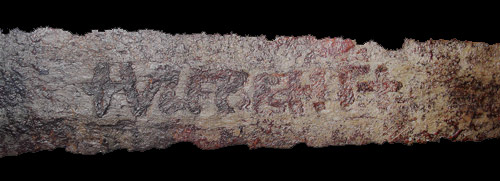The Ulfberht: Mysterious Viking Dealer of Death
on April 23, 2014 at 4:12 am Scholars of Norse mythology determined that February 22 of this year was supposed to be the date of Ragnarok, the Vikings’ (frankly pretty awesome) version of the apocalypse.[1] Fortunately we were spared, but it might be time to brush up on your swordsmanship just in case. And if you need to fend off frost giants, or anything else for that matter, there is no better blade to have with you than an Ulfberht.
Scholars of Norse mythology determined that February 22 of this year was supposed to be the date of Ragnarok, the Vikings’ (frankly pretty awesome) version of the apocalypse.[1] Fortunately we were spared, but it might be time to brush up on your swordsmanship just in case. And if you need to fend off frost giants, or anything else for that matter, there is no better blade to have with you than an Ulfberht.
Ulfberht was a legendary Viking sword, one of the best pre-modern weapons ever made.[2] It was not a single sword, like Excalibur, or a type of sword, like a katana. Ulfberht was actually more like a brand name, only instead of signifying your wealth or trendiness, it signified your ability to kick ass on the battlefield. The name comes from the inscription found on the blade, +ULFBERH+T, which makes them easy to identify and also forms one of Ulfberht’s mysteries.
Ulfberht is assumed to be a Frankish word, though its meaning is unknown. The word may be a “word of power”; which is a word not part of normal language that Vikings believed to be magical. Or perhaps it is a contraction or a portmanteau of some other words that we do not know. The word does resemble a mashup of the Norse word “ulfr,” meaning wolf and the Saxon word “beraht,” meaning bright or shining. So, carrying an Ulfberht may have meant that not only would you survive in a fight, but that you could brag about doing it brandishing a “shining wolf.”[3]
A popular theory is that Ulfberht is the name of a workshop, or the family name of its creator. We know that Ulfberht is not the name of a single smith who crafted each blade, because the swords were crafted over a period of 200 years. So the sword must have either been created by a number of people from the same family or community, or possibly by a Highlander.[4]
Another strange quality of the sword has convinced experts that Ulfberhts all come from one place. The swords are incredibly strong and well-made, easily besting any other sword a Viking would have had access to. The secret lies in the weapon’s steel. Swords at the time were brittle and full of impurities thanks to inefficient smithing techniques and the relatively low temperature at which the steel was melted. Ulfberhts, however, were made of crucible steel purer than anything made in Europe. In fact, Japan wouldn’t see a sword made of equal steel until 300 – 500 years after the Ulfberht.[5] The steel was made in furnaces that could reach 3,000 degrees. Europeans would not develop that technology until the Industrial Revolution, so going into battle against a Viking wielding an Ulfberht must have felt something like facing off against a machine gun with a bow and arrow. It is speculated that even the best Viking smith could not make this steel on their own, so they relied instead on their next best non-pillaging-related skills: sailing and trading.
There were places where crucible steel could be made at the time of the Vikings, in what we would now call the Middle East and Central Asia. Many artifacts have been found in Viking settlements from these regions: including coins, jewelry, and statues. We also know that there was a trade route directly from Scandinavia to modern-day Iran by way of the Volga River.[6] In fact, the latest examples of Ulfberhts we know of, come from right around the time when the Volga trade route was in decline. So it seems likely enough that Ulfberhts creators could have loaded up a boat with furs and helmets and giant casks of mead, took a quick jaunt down the Volga River, and returned with everything they needed to make their nigh-indestructible swords from the steel of the future.
 At a glance, though, these swords would look like any other, except for the inscription. That led Alan Williams, author of The Sword and the Crucible, to uncover a case of ancient fraud.[7] Williams examined 44 of the nearly 200 Ulfberhts that have been discovered, and found that three-quarters of them were, as far as their steel was concerned, not Ulfberhts at all. They were standard swords made of the same metal as any other blade, but inscribed with the word Ulfberht. However, instead of the inscription +ULFBERH+T found on the genuine swords, the fakes were inscribed +ULFBERHT+. This led to the theory that these inferior blades were actually bootlegs, stamped with the name to attract unwary buyers. It was the Viking equivalent of buying a “Polex” watch from a shady vendor in Central Park.
At a glance, though, these swords would look like any other, except for the inscription. That led Alan Williams, author of The Sword and the Crucible, to uncover a case of ancient fraud.[7] Williams examined 44 of the nearly 200 Ulfberhts that have been discovered, and found that three-quarters of them were, as far as their steel was concerned, not Ulfberhts at all. They were standard swords made of the same metal as any other blade, but inscribed with the word Ulfberht. However, instead of the inscription +ULFBERH+T found on the genuine swords, the fakes were inscribed +ULFBERHT+. This led to the theory that these inferior blades were actually bootlegs, stamped with the name to attract unwary buyers. It was the Viking equivalent of buying a “Polex” watch from a shady vendor in Central Park.
We may never know who made the Ulfberht, how they first found out about crucible steel, why no one else learned about their steel supply, or even what the name itself means. Ulfberht’s creators kept these secrets so well that they have endured for a millennium, and it’s likely that they will remain a mystery.
About the Author; Bryan Lawver is a writer and editor in Boston, Massachusetts. He primarily writes about art and artists but has dabbled in fiction as well. Some of his work can be found at bryanlawver.com.
References
[1,] Davis, Lauren. “This Weekend Is Ragnarok. But It Isn’t the End of the World.” Http://io9.com/. N.p., n.d. Web.
[2] Yost, David. “Secrets of the Viking Sword (2012) Full.” YouTube. Nova / PBS, 17 Oct. 2012. Web. 19 Apr. 2014.
[3,6] “Ulfberht – The Origins Of The Powerful Viking Sword.” Utaot.com Mystery, Science, Art and Spirit. N.p., 13 Feb. 2013. Web. 19 Apr. 2014.
[4] Stalsberg, Anne. “The Vlfberht Sword Blades Re-evaluated”.” N.p., n.d. Web..
[5] “Viking Age Arms and Armor Viking Swords.” Hurstwic: Viking Swords. Hurstwic: Viking Swords, n.d. Web. 19 Apr. 2014.
[7] Williams, Alan. The Sword and the Crucible: A History of the Metallurgy of European Swords Up to the 16th Century (History of Warfare). Leiden: Brill, 2012. Print.




